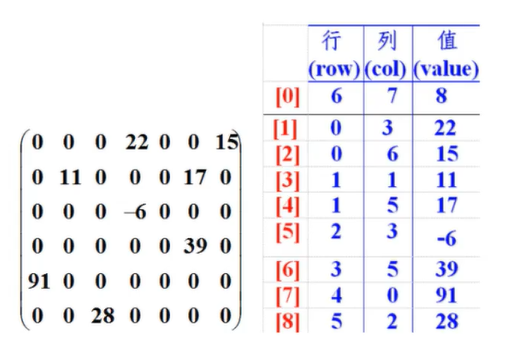参考教程
JDK8帮助文档
狂神说Java视频
数组概念
- 数组是相同类型数据的有序集合。
- 数组描述的是相同类型的若干个数据,按照一定的先后次序排列组合而成。
- 其中,每一个数据称作一个数组元素,每个数组元素可以通过一个下标来访问它们。
数组的声明
1
2
3
| dataType[] arrayRefVar;
或
dataType arrayRefVar[];
|
Java使用new来创建数组:
1
| dataType[] arrayRefVar = new dataType[arratSize];
|
获取数组长度:arrays.length
1
2
3
4
5
6
7
8
9
10
11
12
13
14
15
16
17
18
19
20
21
22
23
24
25
26
| public class Create {
public static void main(String[] args) {
int[] nums1;
int nums2[];
int[] nums;
nums = new int[10];
int[] nums3 = new int[10];
nums[0] = 1;
nums[1] = 1;
nums[2] = 1;
nums[3] = 1;
nums[4] = 1;
int sum = 0;
for (int i = 0; i < nums.length; i++) {
sum+=nums[i];
}
System.out.println(sum);
}
}
|
Java内存分析
堆
- 存放new的对象和数组
- 可以被所有线程共享,不会存放别的对象引用
栈
- 存放基本变量类型(会包含这个基本类型的具体数值)
- 引用对象的变量(会存放这个引用在堆里的具体地址)
方法区
- 可以被所有线程共享
- 包含了所有的class和static变量
数组的三种初始化状态
1
2
3
4
5
6
7
8
9
10
11
12
13
14
| public class Init {
public static void main(String[] args) {
int[] a = {1,2,3,4,5,6,7,8};
System.out.println(a[2]);
int[] b = new int[10];
b[0] = 10;
System.out.println(b[0]);
System.out.println(b[1]);
}
}
|
数组的特点
- 其长度是确定的。数组一旦被创建,它的大小就是不可以改变的。
- 其元素必须是相同类型,不允许出现混合类型。
- 数组中的元素可以是任何数据类型,包括基本类型和引用类型。
- 数组变量属引用类型,数组也可以看成是对象,数组中的每个元素相当于该对象的成员变量。数组本身就是对象,Java中对象是在堆中的,因此数组无论保存原始类型还是其他对象类型,数组对象本身是在堆中的。
数组边界
下标的合法边界:[0, length-1],若越界会报错ArrayIndexOutOfBoundsException:
1
2
| Exception in thread "main" java.lang.ArrayIndexOutOfBoundsException: 11
at Array.Init.main(Init.java:14)
|
- 数组是相同数据类型(数据类型可以为任意类型)的有序集合。
- 数组也是对象,数组元素相当于对象的成员变量。
- 数组长度是确定的,不可变的。如果越界,则报: ArrayIndexOutofBounds。
数组的使用
1
2
3
4
5
6
7
8
9
10
11
12
13
14
15
16
17
18
19
20
21
22
23
24
25
26
27
28
29
30
31
32
33
34
35
36
37
38
| public class Usage {
public static void main(String[] args) {
int[] arrays = {1,2,3,4,5};
for (int array : arrays) {
System.out.println(array);
}
printArray(arrays);
int[] reverse = reverse(arrays);
printArray(reverse);
}
public static void printArray(int[] arrays){
for(int array:arrays){
System.out.print(array+" ");
}
}
public static int[] reverse(int[] arrays){
int[] result = new int[arrays.length];
for (int i = 0, j = result.length-1; i < arrays.length; i++, j--) {
result[j] = arrays[i];
}
return result;
}
}
|
二维数组
多维数组:数组的数组
二维数组:特殊的一维数组,每一个元素都是一个一维数组
二维数组的定义(一个两行五列的数组):
1
| int a[][] = new int[2][5]
|
1
2
3
4
5
6
7
8
9
10
11
12
13
14
15
16
17
18
19
20
21
22
23
24
| public class Two {
public static void main(String[] args) {
int[][] array = {{1,2},{2,3},{3,4},{4,5}};
for(int[] arr:array){
printArray(arr);
}
for (int i = 0; i < array.length; i++) {
for (int j = 0; j < array[i].length; j++) {
System.out.println(array[i][j]);
}
}
}
public static void printArray(int[] arrays){
for(int array:arrays){
System.out.print(array+" ");
}
System.out.println();
}
}
|
Arrays类
数组的工具类:java.util.Arrays
由于数组对象本身并没有什么方法可以供我们调用,但API中提供了一个工具类Arrays供我们使用,从而可以对数据对象进行一些基本的操作。
Arrays类中的方法都是static修饰的静态方法,在使用的时候可以直接使用类名进行调用,而不用使用对象来调用。
1
2
3
4
5
6
7
8
9
10
11
12
13
14
15
16
| public class Class {
public static void main(String[] args) {
int[] a = {1,2,3,4534,2432,43,54,5938,20};
System.out.println(Arrays.toString(a));
Arrays.sort(a);
System.out.println(Arrays.toString(a));
Arrays.fill(a,2,4,0);
System.out.println(Arrays.toString(a));
}
}
|
常用功能:
- 给数组赋值:通过
fill方法。
- 对数组排序:通过
sort方法,升序。
- 比较数组:通过
equals方法比较数组中元素值是否相等。
- 查找数组元素:通过
binarySearch方法能对排序好的数组进行二分查找法操作。
冒泡排序
1
2
3
4
5
6
7
8
9
10
11
12
13
14
15
16
17
18
19
20
21
22
23
24
25
26
27
28
29
30
31
32
33
34
| public class BubbleSort {
public static void main(String[] args) {
int[] a = {1,2,3,4534,2432,43,54,5938,20};
System.out.println(Arrays.toString(sort(a)));
}
public static int[] sort(int[] array){
for (int i = 0; i < array.length - 1; i++) {
boolean flag = false;
for (int j = 0; j < array.length - 1 - i; j++) {
if (array[j + 1] < array[j]){
int temp = array[j];
array[j] = array[j + 1];
array[j + 1] = temp;
flag = true;
}
}
if (!flag) {
break;
}
}
return array;
}
}
|
稀疏数组
当一个数组中大部分元素为0,或者为同一个值,可以使用稀疏数组来保存该数组。
稀疏数组的处理方式是:
- 记录数组一共有几行几列,有多少个不同值(存放在稀疏数组的第一行)
- 把具有不同值的元素的行列&值记录在一个小规模数组中
示例:

1
2
3
4
5
6
7
8
9
10
11
12
13
14
15
16
17
18
19
20
21
22
23
24
25
26
27
28
29
30
31
32
33
34
35
36
37
38
39
40
41
42
43
44
45
46
47
48
49
50
51
52
53
54
55
56
57
58
59
60
61
62
63
| public class Sparse {
public static void main(String[] args) {
int[][] array1 = new int[11][11];
array1[1][2] = 1;
array1[2][3] = 2;
printArray(array1);
int sum = 0;
for (int i = 0; i < array1.length; i++) {
for (int j = 0; j < array1[i].length; j++) {
if (array1[i][j]!=0){
sum++;
}
}
}
System.out.println("有效值个数:"+sum);
int[][] array2= new int[sum+1][3];
array2[0] = new int[]{array1.length, array1[0].length, sum};
int count = 0;
for (int i = 0; i < array1.length; i++) {
for (int j = 0; j < array1[i].length; j++) {
if (array1[i][j]!=0){
count++;
array2[count][0] = i;
array2[count][1] = j;
array2[count][2] = array1[i][j];
}
}
}
printArray(array2);
int[][] array3 = new int[array2[0][0]][array2[0][1]];
for (int i = 1; i < array2.length; i++) {
array3[array2[i][0]][array2[i][1]] = array2[i][2];
}
printArray(array3);
}
public static void printArray(int[][] array){
for (int[] ints : array) {
for (int anInt : ints) {
System.out.print(anInt+"\t");
}
System.out.println();
}
}
}
|


